Bài giảng Kỹ thuật nâng. Vận chuyển - Chương 3: Dây và các chi tiết quấn, hướng dây
Cấu tạo:
-Chế tạo từ những sợi thép
sáng hay tráng kẽm đường kính
từ 0,2-3mm đã được hóa cứng
? Kết cấu
? Tùy theo cách bện:
-Bện đơn
-Bện kép
-Bện ba lớp
? Tùy theo chiều cuốn :
-Bện xuôi
- bện chéo
- Bện tổng hợp
1. DÂY CÁP THÉP (tt)
(wire rope)
? Tùy theo tình trạng tíêp xúc :
-Tiếp xúc đường
-Tiếp xúc điểm
Tính và chọn dây
1. Individual wires, the ropes – an object of intricate constructionis composed of, are subject to various stresses in service
(contact, tension, bending, and twisting)
2. A mathematical treatment of all the factors controlling the
wires of rope is practical impossible
3. Codes used in rope design are based on factors of maximum
rope tension, and safety
4. Ropes are selected from applicable standards, using the
relationship
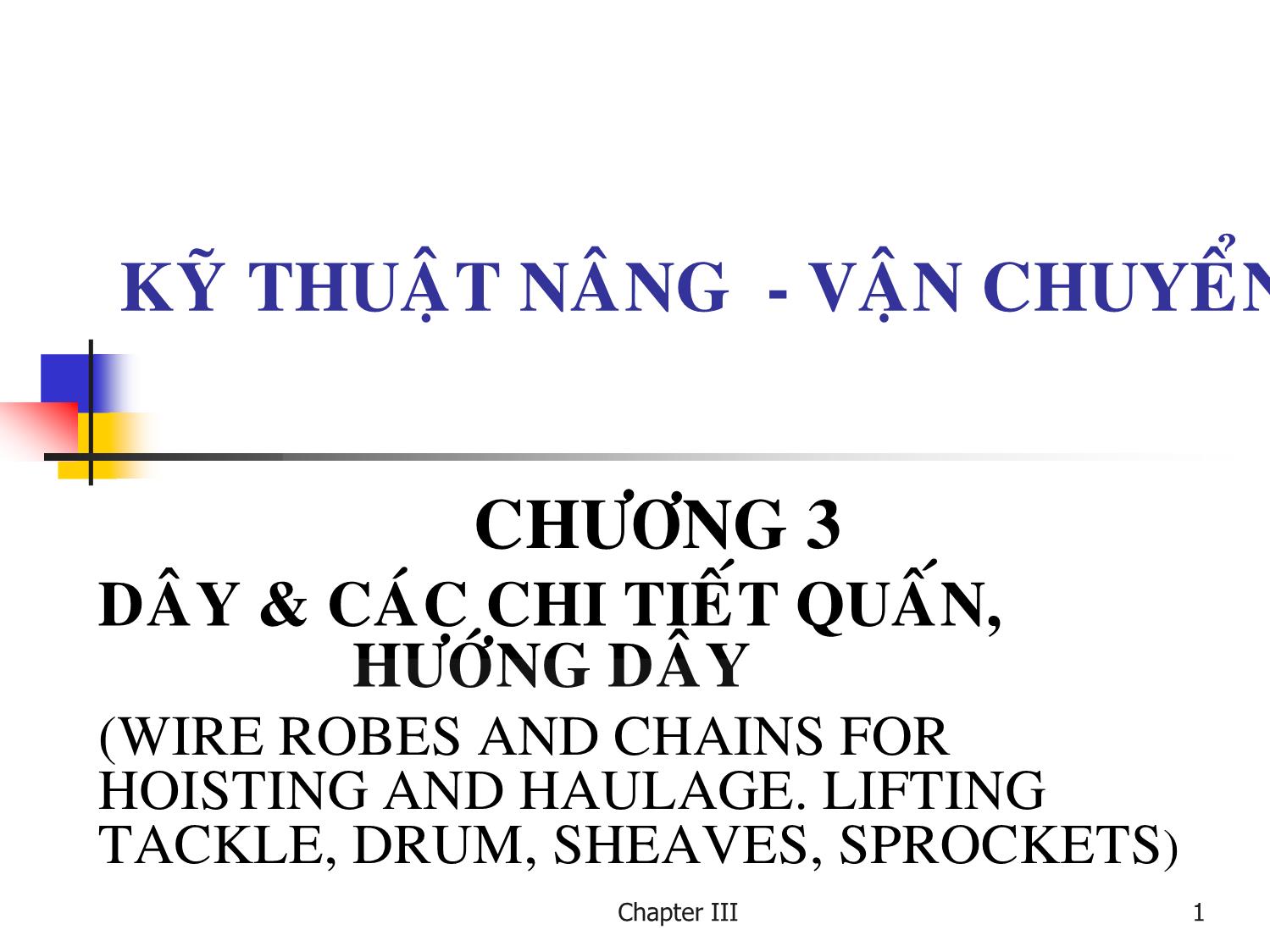
Trang 1
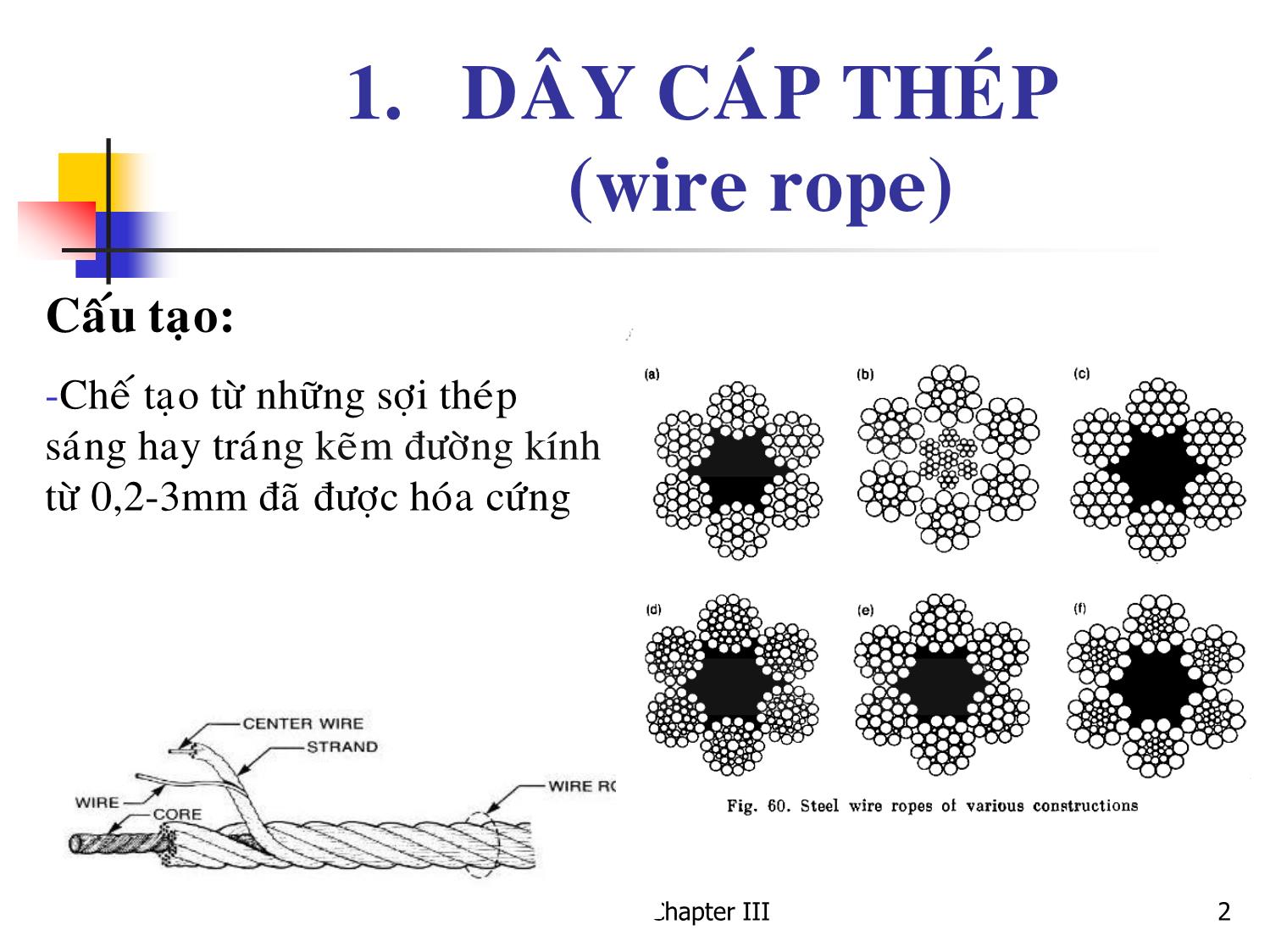
Trang 2
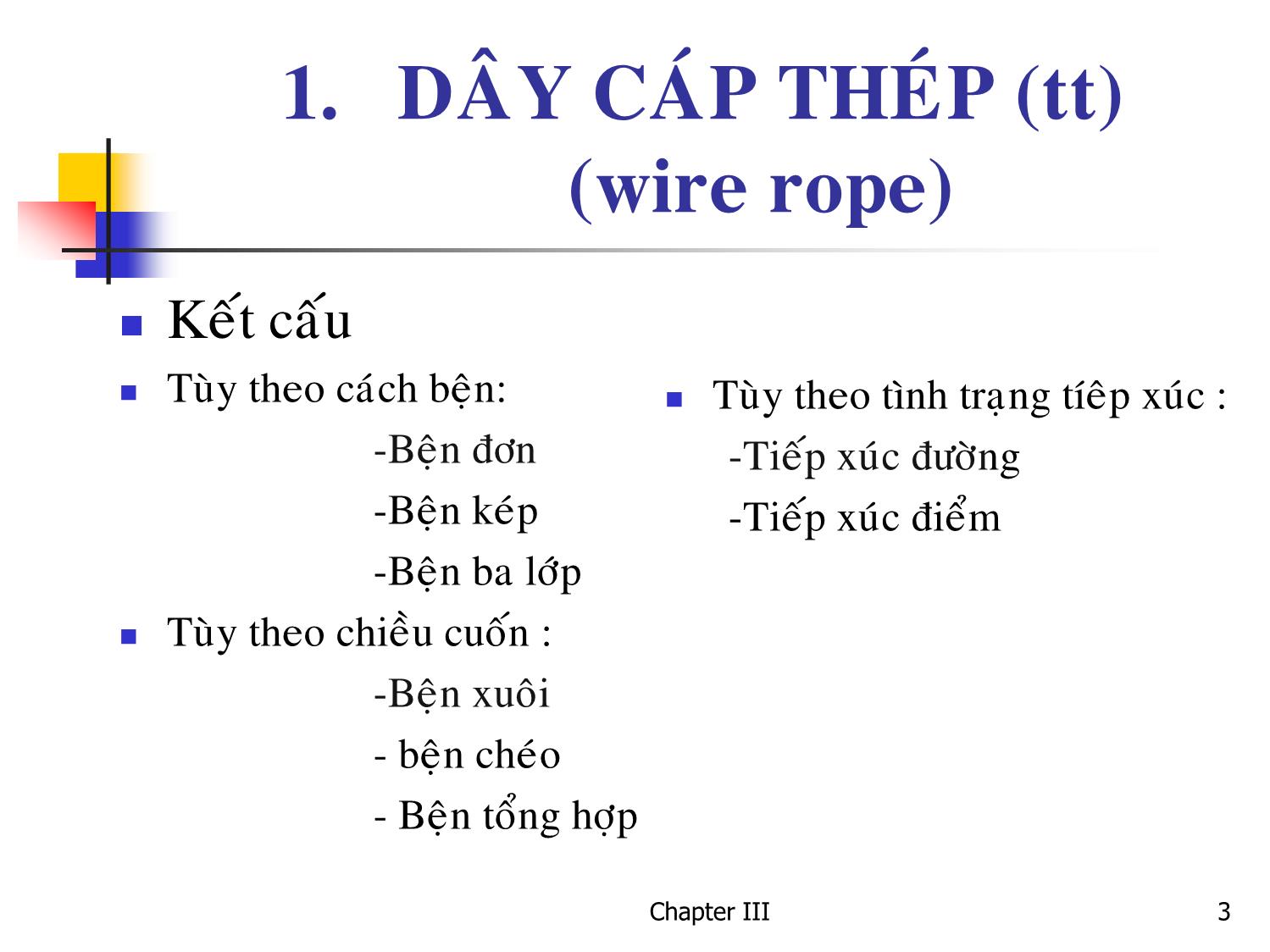
Trang 3

Trang 4

Trang 5

Trang 6

Trang 7
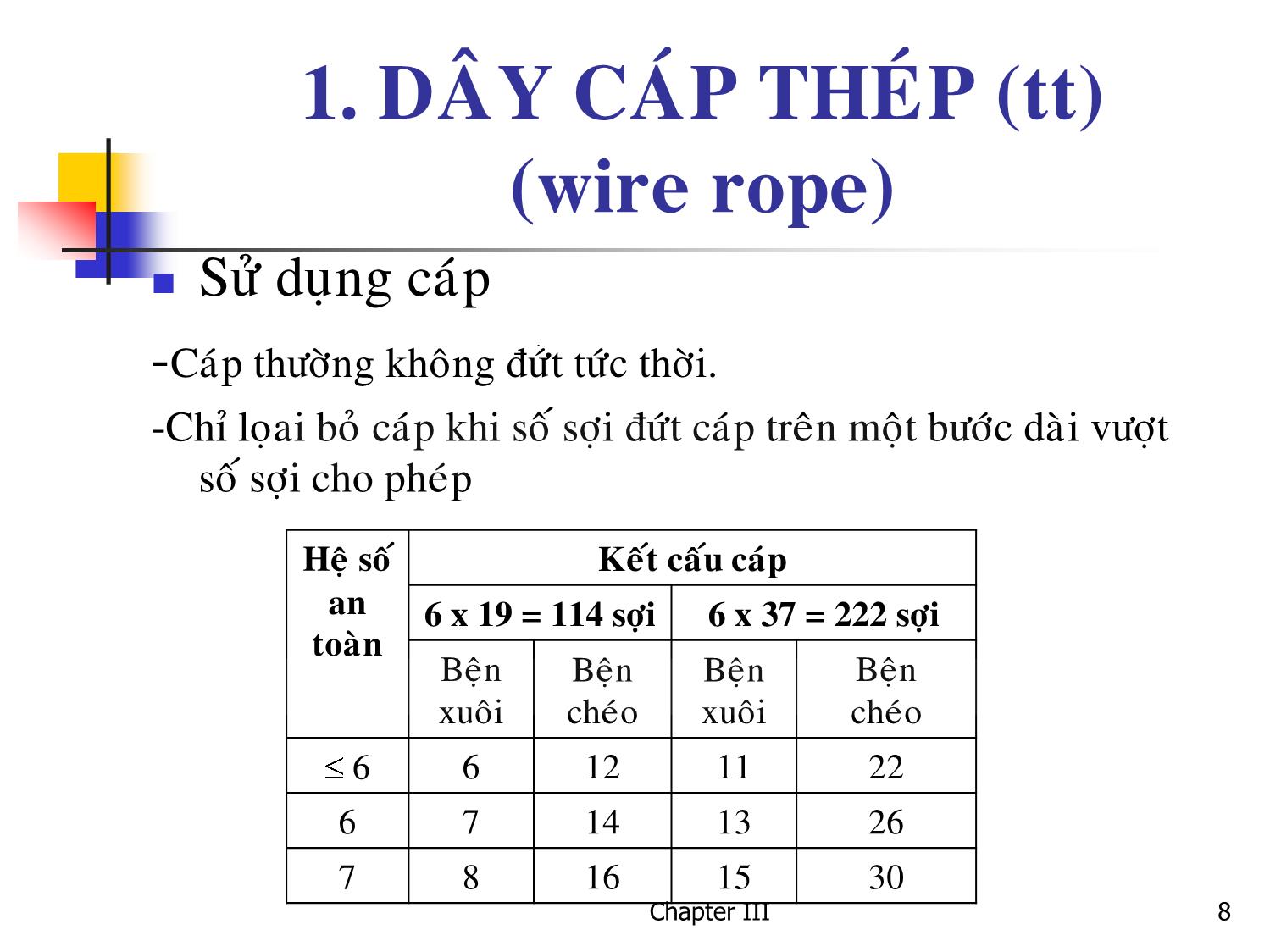
Trang 8
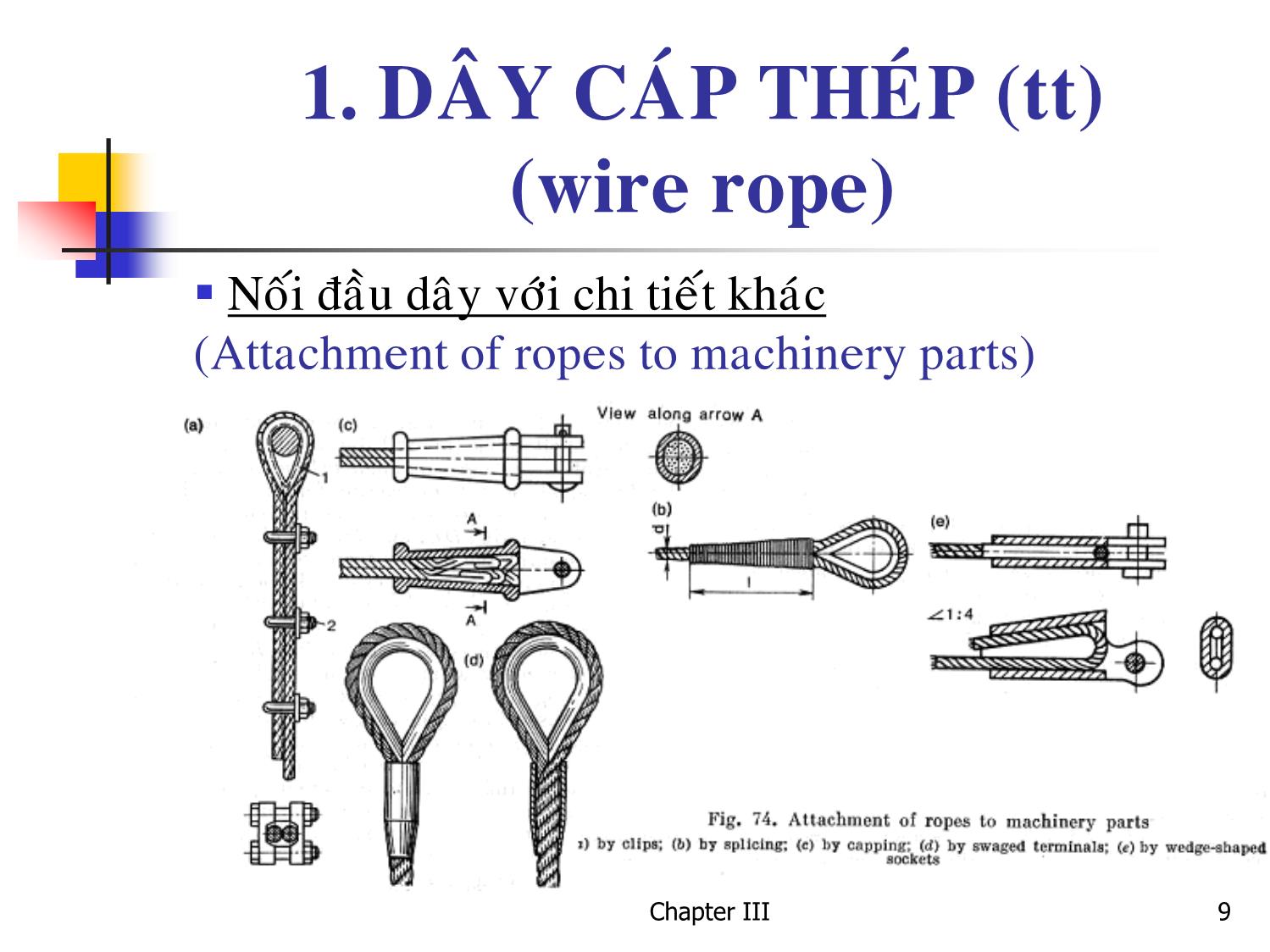
Trang 9
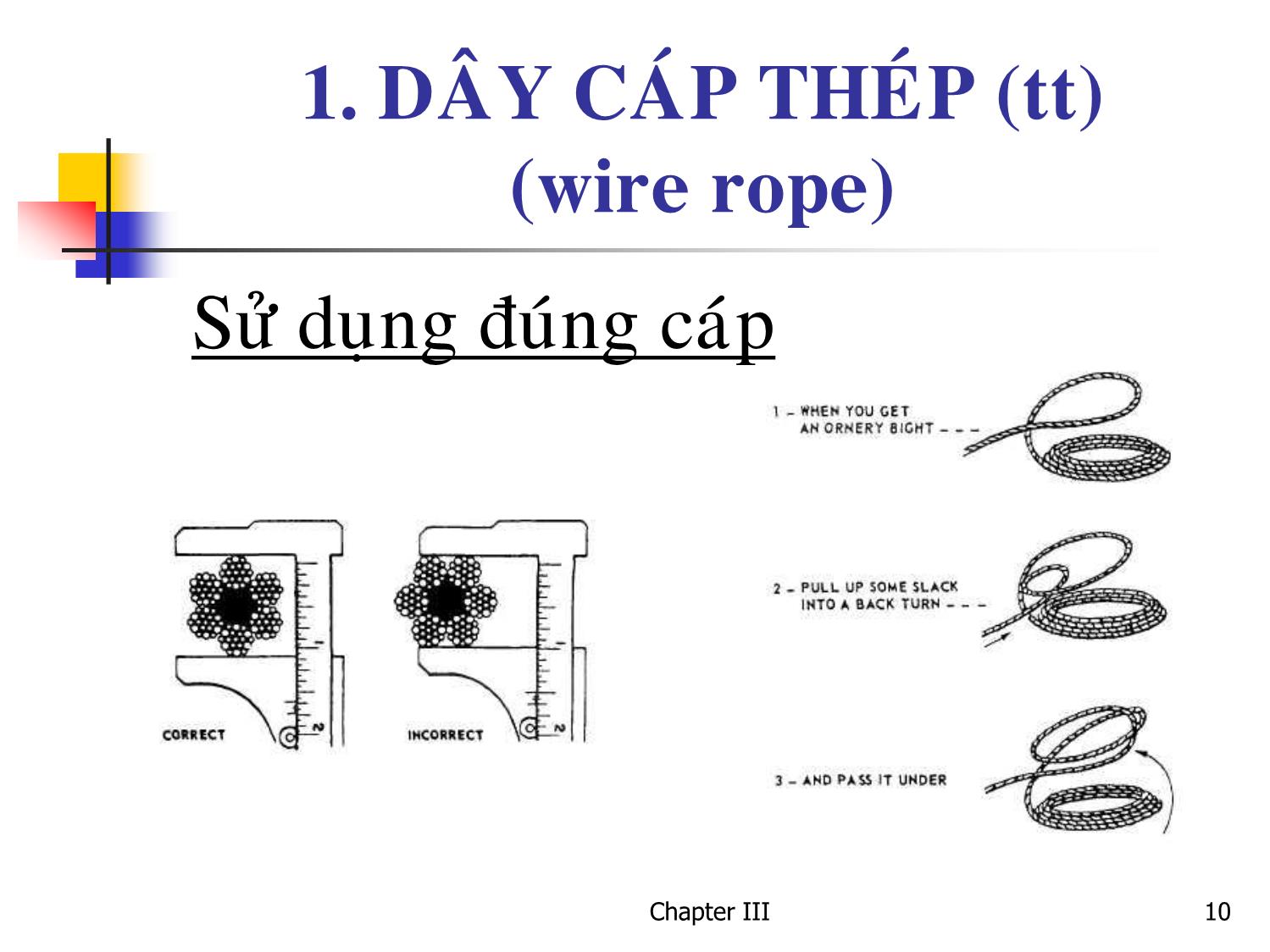
Trang 10
Tải về để xem bản đầy đủ
Tóm tắt nội dung tài liệu: Bài giảng Kỹ thuật nâng. Vận chuyển - Chương 3: Dây và các chi tiết quấn, hướng dây
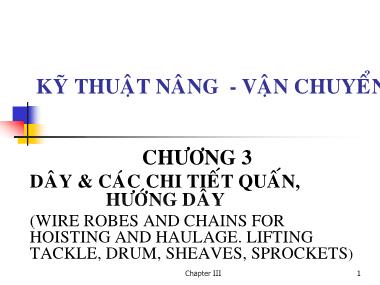
Chapter III 1
KỸ THUẬT NÂNG - VẬN CHUYỂN
CHƯƠNG 3
DÂY & CÁC CHI TIẾT QUẤN,
HƯỚNG DÂY
(WIRE ROBES AND CHAINS FOR
HOISTING AND HAULAGE. LIFTING
TACKLE, DRUM, SHEAVES, SPROCKETS)
Chapter III 2
1. DÂY CÁP THÉP
(wire rope)
Cấu tạo:
-Chế tạo từ những sợi thép
sáng hay tráng kẽm đường kính
từ 0,2-3mm đã được hóa cứng
Chapter III 3
Kết cấu
Tùy theo cách bện:
-Bện đơn
-Bện kép
-Bện ba lớp
Tùy theo chiều cuốn :
-Bện xuôi
- bện chéo
- Bện tổng hợp
1. DÂY CÁP THÉP (tt)
(wire rope)
Tùy theo tình trạng tíêp xúc :
-Tiếp xúc đường
-Tiếp xúc điểm
Chapter III 4
1. DÂY CÁP THÉP (tt)
(wire rope)
•Bện kép
Chapter III 5
1. DÂY CÁP THÉP (tt)
(wire rope)
Chapter III 6
1. DÂY CÁP THÉP (tt)
(wire rope)
LLL %20rope LRL %20rope
RLL %20rope
RRL %20rope
Cấu tạo theo chiều cuốn
Chapter III 7
d
SSn
d
S
max
.
Tính và chọn dây
1. Individual wires, the ropes – an object of intricate construction-
is composed of, are subject to various stresses in service
(contact, tension, bending, and twisting)
2. A mathematical treatment of all the factors controlling the
wires of rope is practical impossible
3. Codes used in rope design are based on factors of maximum
rope tension, and safety
4. Ropes are selected from applicable standards, using the
relationship
1. DÂY CÁP THÉP (tt)
(wire rope)
Chapter III 8
Sử dụng cáp
-Cáp thường không đứt tức thời.
-Chỉ lọai bỏ cáp khi số sợi đứt cáp trên một bước dài vượt
số sợi cho phép
Hệ số
an
toàn
Kết cấu cáp
6 x 19 = 114 sợi 6 x 37 = 222 sợi
Bện
xuôi
Bện
chéo
Bện
xuôi
Bện
chéo
6 6 12 11 22
6 7 14 13 26
7 8 16 15 30
1. DÂY CÁP THÉP (tt)
(wire rope)
Chapter III 9
Nối đầu dây với chi tiết khác
(Attachment of ropes to machinery parts)
1. DÂY CÁP THÉP (tt)
(wire rope)
Chapter III 10
1. DÂY CÁP THÉP (tt)
(wire rope)
•Sử dụng đúng cáp
Chapter III 11
1. DÂY CÁP THÉP (tt)
(wire rope)
Chapter III 12
1. DÂY CÁP THÉP (tt)
(wire rope)
Chapter III 13
1. DÂY CÁP THÉP (tt)
(wire rope)
Chapter III 14
1. DÂY CÁP THÉP (tt)
(wire rope)
Chapter III 15
1. DÂY CÁP THÉP (tt)
(wire rope)
Chapter III 16
Phương pháp cố định đầu cáp trên tang
1. DÂY CÁP THÉP (tt)
(wire rope)
Chapter III 17
2. XÍCH (chains)
Xích hàn (welded)
-These are widely used in hoisting
installation as pliable members
-Welded chains fall in to ordinary
type and calibrated one differing
by the accuracy of fabrication
Xích bản lề ( roller chains)
-Roller chains consist of steel plates hinge- joined by pins
-Normally the chains are tested by the manufacturer with a load
equal to half the breaking one
-Roller chains are ore reliable than welded
- Roller chains are heavier and more costly then welded ones
Chapter III 18
3. TANG CUỐN CÁP (drums)
Mục đích:
Phân loại:
Tang trụ.
Tang côn.
Tang ma sát.
Cấu tạo, chế tạo:
Một lớp, nhiều lớp.
Có rãnh, không có rãnh.
Đúc hàn.
Chapter III 19
3. TANG CUỐN CÁP( tt) :
1. Tang trụ.
-Distinction is made between drums spooling
the rope in one layer and those on which
the rope is wound is more than one layer
- The winding face of drum is made smooth
or provided machined helical grooves
Các thông số cơ bản : L,t, D
Chapter III 20
3. TANG CUỐN CÁP( tt) :
Chapter III 21
3.TANG CUỐN CÁP (drums) tt
D (e-1)d
c
L=L
0
+L
1
+2L
2
L
0
=Z.t ={l/ (D+d
c
)}t +(1,5-2)t
L
0
=Z.t ={a.H/ (D+d
c
)}t +(1,5-2)t
t=d
c
+(2-3)mm
Chapter III 22
Chiều dầy tang
-Tang bằng gang: =0,02D+(6-10) mm
-Tang bằng thép: =1,2d
c
Tính bền tang
-L/D<3: kiểm tra nén:
n
=k.S
max
/ .t [
n
]
- L/D 3:kiểm tra uốn, xoắn:
u
=M
u
/W
u
x
=M
x
/W
x
-Tổng ứng suất: 2
x
2
un
3)(
3.TANG CUỐN CÁP (drums) tt
Chapter III 23
3.TANG CUỐN CÁP (drums) tt
Tang côn
Mục đích:
Phạm vi sử dụng.
maxminminmax
SDSD
Chapter III 24
3. TANG CUỐN CÁP( tt) :
Chapter III 25
3. TANG CUỐN CÁP( tt) :
3. Tang và puly ma sát.
Mục đích.
Phạm vi sử dụng.
Capstan drums (traction –type drum)
The rope connected to the
load is not fastened to the drum
but is held fast to it owing to
traction between the drum
surface and a few turn of rope
coiled around the drum
Hence according to Euler,
the tension in the entering
side of rope connected to
the load is given:
S
e
=S
l
e
f
Chapter III 26
4. PULY (sheaves)
Puly cáp.
(Sheave grooves)
Puly xích (sprockets)
- Chain sheave for
welded chain
- Sprocket for roller
Chapter III 27
4. PULY (tt):
Đối với xích: D
0
≥ 20d
Đối với cáp: D ≥ (e-1)d
c
Bán kính của rãnh: r = (0,6 – 0,7)d
c
Chapter III 28
4. PULY (tt) :
-Hiệu suất puly
từ đây ta tìm được W
c
với
Lực cản ổ trục:
với
Hiệu suất puly:
)
2
)(()
2
(
11
b
D
WSa
D
S
c
111
.
2
. S
b
D
ba
SW
c
bD
ba
2
1
121
...
2
..2
2
S
D
d
f
a
S
D
M
W
ms
ms
04,001,0
2
sin2
2
D
d
f
1
1
1
211
1
2
1
2 msc
WWS
S
S
S
hS
Qh
Chapter III 29
DEFINITION
A lifting tackles is a system of stationary and movable
sheaves interlinked by a pliable member in form of a wire
rope to obtain a gain in either force ( power lifting tackle)
or speed ( speed lifting tackle)
5. PALĂNG (Lifting tackles)
Chapter III 30
5. PALĂNG (Lifting tackles)
a
Q
S
0
Định nghĩa.
Đặc tính cơ bản: bội suất a
Ý nghĩa vật lý:
tangvào dây Số
vậttreo dây Số
a
Chapter III 31
Hiệu suất palăng và
lực căng dây lớn nhất:
Khi nâng:
1a
a21
1a
1a
2
123
12
1
...1SS....SSQ
S....S
...
SSS
SS
S
a1
1
1
QS
5. PALĂNG (Lifting tackles) tt
Chapter III 32
tat
1
maxtg
1
1QS
SS
Lực cáp lên tang:
t: số puly đổi hướng
5. PALĂNG (Lifting tackles) tt
Chapter III 33
5. PALĂNG (tt):
Hiệu suất palăng
Lực căng cáp lớn
nhất
h.a.S
h.Q
tg
pl
a1
1
n
ta
pl
pl
max
.a
Q
S
Công có ích
Công toàn phần
Chapter III 34
Palăng kép
5. PALĂNG (Lifting tackles) tt
Chapter III 35
Các sơ đồ pa lăng lợi lực
5. PALĂNG (Lifting tackles) tt
Chapter III 36
5. PALĂNG (Lifting tackles) tt
Các sơ đồ pa lăng lợi lực
Chapter III 37
5. PALĂNG (Lifting tackles) tt
Các sơ đồ pa lăng lợi lực
Chapter III 38
5. PALĂNG (Lifting tackles)
Các sơ đồ pa lăng lợi lực
Chapter III 39
A velocity lifting tackle
-The principles of velocity lifting
tackle design are basically the
same as those employed for its
power counterpart.
-When the lifting tackle frame (point
A) displaces through a distance h,
the load moves through the
distance H=ah, Where a is number
of rope part reeved through the
velocity lifting tackle.
-Hence, the velocity of hoisting the
load is
- Vload =a.V A
5. PALĂNG (Lifting tackles) tt
-Pa lăng lợi tốc-
Chapter III 40
5. PALĂNG (Lifting tackles) tt
-Pa lăng lợi tốc-
Chapter III 41
5. PALĂNG (Lifting tackles) tt
-Pa lăng lợi tốc-
Chapter III 42
5. PALĂNG (Lifting tackles) tt
-Pa lăng lợi tốc-
Chapter III 43
DÂY & CÁC CHI TIẾT QUẤN,
HƯỚNG DÂY
ANY QUESTIONS ?
..
THANK YOU
File đính kèm:
 bai_giang_ky_thuat_nang_van_chuyen_chuong_3_day_va_cac_chi_t.pdf
bai_giang_ky_thuat_nang_van_chuyen_chuong_3_day_va_cac_chi_t.pdf

